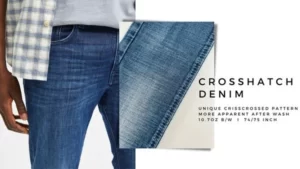Denim is a cotton twill fabric, often dyed with indigo, used to make jeans, jackets, and other casual clothing. Over the years, denim has evolved from a workwear fabric to a fashion statement.
Today, denim is a fashion staple, available in a variety of styles and shapes.
There are two main types of denim on the market – woven and knitted.
In this article, we explore the advantages of knitted denim over woven denim, the innovativeness, sustainability, and versatility of knitted denim, and examples of successful implementations.
What Is the Difference Between Woven and Knit Denim?
Woven Denim
- Made by weaving a set of horizontal threads (weft threads) above and below the vertical threads (warp threads).
- Usually stiff at first and may take some time to get used to and become comfortable.
- Less stretch and less resistant to the body than jersey denim.
- Typically more durable and dries faster than jersey denim.
Knitted Denim
- Made of interlocking yarn loops that give it stretch and comfort.
- More forgiving to the body as it stretches and conforms to the shape of the wearer.
- Immediately soft and comfortable, no break-in period required.
- Due to its stretch, it is generally not as durable as woven denim and may be more prone to holes or tears.
- Often more environmentally friendly as it requires less water and produces less waste than woven denim.
Overall, the choice between woven and knitted denim comes down to personal preference and intended use. Woven denim may be better for workwear or heavy-duty use, while knitted denim may be better for more versatile, comfortable everyday wear.
Knitted Denim vs Woven Denim
- Fabric structure
Woven-based denim is made in different ways, the most common being a traditional weave in which the threads run perpendicular to each other.
Knit denim, on the other hand, is made by looping cotton fibers on a circular knitting machine, which makes the fabric more stretchy and soft.
During denim weaving, the fibers are woven together vertically or diagonally, looking for traditional denim, but denim fabrics weaved diagonally are more comfortable to the touch.

- Comfort fit
Knitted denim is known for its comfort. The knit construction of the fabric makes it stretchable, making it easier to wear and move around, and not as stiff and sometimes uncomfortable as woven denim. The flexibility of knitted denim makes it ideal for activewear, where movement is important.
In contrast, woven denim can sometimes feel too tight or too loose, depending on the fit.
- Durability and flexibility
Knit denim is very strong and flexible. The loops of the fibers allow jersey denim to move and bend without breaking, which is why it’s ideal for activewear.
Additionally, knitted denim is pill-resistant, which means it doesn’t form small fiber balls on the surface as woven denim does. Overall, knitted denim is more durable and flexible than woven denim.
The Benefits of Knitted Denim
- Innovation
Innovation is an important aspect of knitted denim. Newer knitting techniques allow more precise control of thread placement during weaving, resulting in new denim fabrics with different stretch and textural properties. Technological advancements have made knitted denim a more popular choice, leading companies to increase investments in knitted denim production to meet demand.

- Sustainability
Knitted denim is more environmentally friendly than woven denim. Circular knitting machines producing knitted denim have the potential to reduce the wasteful process. Unlike braiding machines, which require more cutting and trimming to achieve the final shape and size, circular knitting machines output almost no scrap. Knitted denim is also easy to recycle since it is already a continuous cycle without any seemingly useless additions.
- Versatility
One of the great things about knitted denim is its versatility. It can be worn with various fashion styles without looking out of place. It is flexible and adaptable, perfect for different occasions and atmospheres.
Knit denim can be worn for formal or casual occasions and is versatile enough to be used in jackets, trousers, skirts, and other garments.
Examples of Successful Implementation
- Brands that have successfully implemented knitted denim
Brands that have successfully implemented jersey denim include Levi’s, J Brand, and AG Jeans. These brands have launched more comfortable and fashionable knitted denim jeans, which have set off a trend of comfort and fashion among consumers.
- Testimonials from customers who switched to knitted denim
Many consumers have attested to the comfort of knitted denim. They switched from traditional woven denim to knitted denim, impressed by its flexible feel and durability. Customer testimonials show that jersey denim is the go-to choice for consumers looking for comfortable yet stylish everyday wear.
- Examples of fashion trends and styles incorporated into knitted denim
Fashion trends are always changing, but jersey denim has proven to be a fabric that adapts to fashion. Knit denim comes in a variety of styles, such as boyfriend jeans, skinny jeans, and cropped jeans.
Knitted denim was worn by models and regular folks on the runway, and it became clear that jersey denim was not just a passing trend, but the new standard in denim fashion.
What Fake Knit Denim We Can Provide You?
Fake Knitted Denim in ZEVA DENIM. We also have a Knit-like denim style.
From mid-weight to heavy-weight, fabrics with different yarn qualities are available. But all are the same in incredible soft hand touch!
Classic surface and backside, very similar to knit denim. The surface is crisp right-hand twill. The back is filled with cotton loops like French terry, which is created by woven technology. It has an ultra-soft and full-hand feel. Ideal for next-to-skin jeans.

If you want to know more please click Fake Knitted Denim in ZEVA DENIM.
People Also Ask
- What is the Best Type of Denim?
The “best” type of denim depends on personal preference and use. For durability, traditional 100% cotton denim is excellent. For comfort and flexibility, stretch denim with a mix of cotton and elastane is popular.
- What are the Properties of Knit Denim?
Knit denim is softer and more stretchable than woven denim. It offers more comfort and flexibility, resembling the feel of sweatpants while maintaining a denim look.
- What is the Best Fabric Composition for Jeans?
The best fabric composition for jeans varies based on preference. Traditional jeans are 100% cotton for durability. For comfort and fit, a blend of cotton with 1-3% elastane (for stretch) is preferred by many.
- What is the Denim-like Effect on Knitted Fabrics?
A denim-like effect in knitted fabrics refers to achieving the look of denim using knitting techniques. These fabrics are softer and stretchier than woven denim but have a similar visual appearance to traditional denim.
- What is the difference between knit denim and woven denim?
The main difference between knit denim and woven denim is in how they are made:
- Knit Denim: Made using a knitting process, resulting in a fabric that is stretchier and softer. It feels more like wearing a comfortable, flexible knit garment but looks like denim.
- Woven Denim: Made using a weaving process, typically with a twill weave. This creates a more rigid and durable fabric, which is what traditional jeans are made from. It’s less stretchy and has a firmer texture.
Conclusion
Knitted denim has many advantages over woven denim. It is more comfortable, durable, flexible, environmentally friendly, and versatile. Knitted denim has seen many successful implementations in the fashion industry and the future looks bright.
As more and more brands focus on using knitted denim, its popularity, affordability, and availability will continue to increase. Consumers can be confident that their investment in knitted denim will pay off in comfort and style.





